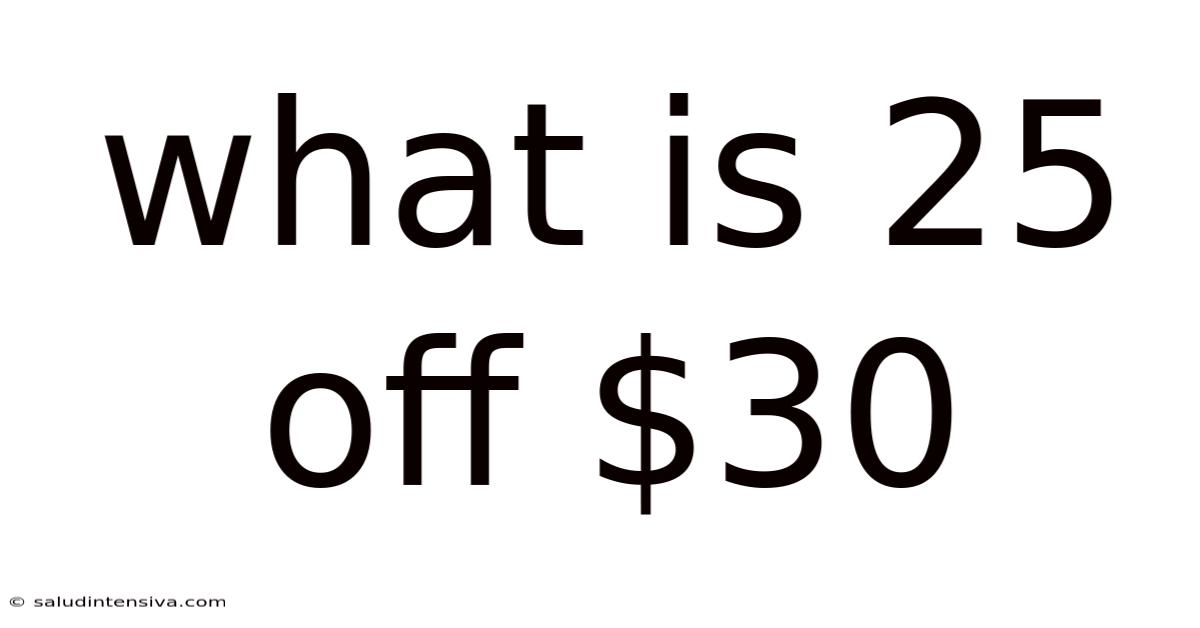What Is 25 Off $30
saludintensiva
Sep 12, 2025 · 4 min read

Table of Contents
What is 25% Off $30? A Comprehensive Guide to Percentage Discounts
Calculating discounts is a fundamental skill in everyday life, whether you're shopping for groceries, comparing prices, or even budgeting your finances. Understanding how to calculate percentage discounts helps you make informed decisions and save money. This article will thoroughly explain how to calculate 25% off $30, providing various methods, exploring the underlying math, and answering frequently asked questions. We'll go beyond just finding the final price and delve into the broader concept of percentage calculations, making you confident in tackling similar problems.
Understanding Percentage Discounts
Before we dive into calculating 25% off $30, let's establish a clear understanding of percentage discounts. A percentage discount represents a reduction in the original price of an item. It's expressed as a percentage of the original price. For example, a 25% discount means that the price is reduced by 25% of its original value.
Method 1: Calculating the Discount Amount First
This is arguably the most straightforward method. It involves two steps:
-
Calculate the discount amount: To find 25% of $30, we first convert the percentage to a decimal by dividing it by 100: 25% / 100 = 0.25. Then, we multiply this decimal by the original price: 0.25 * $30 = $7.50. This means the discount is $7.50.
-
Subtract the discount from the original price: Subtract the discount amount from the original price to find the final price: $30 - $7.50 = $22.50.
Therefore, 25% off $30 is $22.50.
Method 2: Calculating the Final Price Directly
This method is slightly more efficient and involves only one step. It leverages the fact that if you're taking 25% off, you're essentially paying 75% (100% - 25%) of the original price.
-
Calculate the percentage remaining: 100% - 25% = 75%
-
Convert the percentage to a decimal: 75% / 100 = 0.75
-
Multiply the decimal by the original price: 0.75 * $30 = $22.50
This directly gives you the final price after the discount: $22.50.
The Underlying Math: Proportions and Percentages
The foundation of percentage calculations lies in the concept of proportions. A percentage is simply a fraction out of 100. When we say 25% of $30, we are essentially finding 25/100 of $30. This can be expressed as a proportion:
25/100 = x/$30
To solve for x (the discount amount), we cross-multiply:
100x = 25 * $30
100x = $750
x = $750 / 100
x = $7.50
This confirms the discount amount is $7.50, leading to a final price of $22.50.
Applying this to other scenarios: This same proportional method can be used to calculate any percentage discount on any price. Simply replace the values accordingly. For instance, to find 15% off $50, the proportion would be:
15/100 = x/$50
Practical Applications Beyond Shopping
The ability to calculate percentage discounts extends far beyond simple shopping scenarios. It's crucial in various aspects of life, including:
-
Finance: Calculating interest rates, loan repayments, and investment returns all rely on percentage calculations. Understanding discounts helps you compare financial products effectively.
-
Sales and Marketing: Businesses use percentage discounts as powerful tools for attracting customers and increasing sales. Analyzing sales data often involves calculating percentage changes in revenue, profit margins, and customer engagement.
-
Data Analysis: Percentage changes are used extensively in interpreting data across numerous fields, from analyzing population growth to tracking economic indicators. Understanding percentages is crucial for interpreting statistical information effectively.
-
Everyday Budgeting: Calculating percentages helps with budgeting effectively. For example, you might decide to allocate a certain percentage of your income to savings or entertainment.
Frequently Asked Questions (FAQs)
-
What if the discount is not a whole number? The methods described above work equally well with non-whole number percentages. For example, to calculate 17.5% off $60, you would convert 17.5% to a decimal (0.175) and proceed as before.
-
How do I calculate the original price if I know the discounted price and the percentage discount? This involves working backward. Let's say the discounted price is $22.50 and the discount was 25%. This means the discounted price represents 75% (100% - 25%) of the original price. Set up a proportion:
75/100 = $22.50/x
Solving for x (the original price) gives you:
x = ($22.50 * 100) / 75 = $30
- Can I use a calculator? Absolutely! Calculators make these calculations quicker and easier, especially with more complex percentages.
Conclusion: Mastering Percentage Calculations
Mastering percentage calculations is a valuable skill with far-reaching applications. Understanding how to calculate 25% off $30, as we've demonstrated, is not just about finding a sale price; it's about grasping a fundamental mathematical concept that empowers you to make informed decisions in various aspects of your life. By understanding the underlying principles and utilizing different calculation methods, you can confidently tackle any percentage discount problem, improving your financial literacy and decision-making abilities. Remember the core concepts of proportions and decimal conversions, and you'll be well-equipped to handle percentage calculations with ease.
Latest Posts
Latest Posts
-
7 16 Vs 5 8
Sep 12, 2025
-
Formula For Final Kinetic Energy
Sep 12, 2025
-
What Is Equivalent To 3 2
Sep 12, 2025
-
Can 3 5 Be Simplified
Sep 12, 2025
-
Least Common Multiple Of 40
Sep 12, 2025
Related Post
Thank you for visiting our website which covers about What Is 25 Off $30 . We hope the information provided has been useful to you. Feel free to contact us if you have any questions or need further assistance. See you next time and don't miss to bookmark.